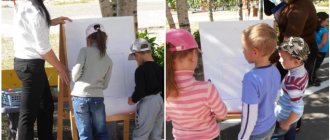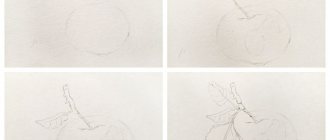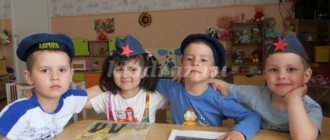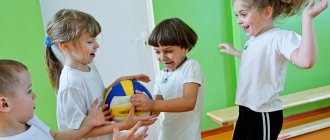Lesson on familiarization with the surrounding world “Birds of Migratory” in the senior group of kindergarten
Lesson on familiarization with the surrounding world “Birds of Migratory” in the senior group of kindergarten
Tasks:
To consolidate children's knowledge about wild migratory birds, the ability to distinguish them, group them, describe the appearance of birds, their characteristics, behavior;
Develop coherent speech - use complex sentences (because).
Develop observation skills and the ability to draw conclusions.
To instill in children a caring attitude towards birds.
Materials:
cards with images of birds, bird masks, cut-out pictures, down and flight feathers of birds, fans.
Preliminary work:
Conversations about birds, bird watching, reading stories, fairy tales and poems about birds, looking at illustrations, watching films.
Teacher: - Guys, the postman brought us an unknown letter. The letter contains the recipient's address in the village of Sadovaya kindergarten. And the sender's address is unknown. Let's open the envelope, maybe there's a clue there.
(The teacher shows the children cut-out pictures)
Teacher: - Some pictures, what should we do with them?
Children: - Collect.
Children collect a picture of the Ugly Duckling and the Swan.
Teacher: - Who turned out? What fairy tale is this hero from?
Teacher: - Here is a letter from the swan: Guys, you correctly remembered the fairy tale by H. H. Andersen “The Ugly Duckling.” I grew up in a poultry yard with poultry and I know everything about them, and now, returning from warmer climes, I met flocks of migratory wild birds, I don’t know anything about them, help me, tell me about them.
Teacher: - Guys, let's help the swan? Let's remember wild migratory birds. Let's play a game.
Game: “Not a magpie, not a crow and not a seagull”
(children stand in a circle)
The teacher says the words: Not a magpie, not a crow or a seagull, but guess what kind of bird it is, and shows each child a picture of a bird:
(owl, cuckoo, swallow, starling, nightingale, wagtail, rook, heron, crane, stork)
Teacher: - I suggest playing the game “Name the extra bird” (children sit on chairs)
(The flannelgraph displays pictures of birds:
Swallow, rook, cuckoo, owl, nightingale, chicken
Teacher: Which bird is the odd one out? Why?
Why are other birds called wild? (They live independently, get their own food, build their own housing).
What benefits do wild birds bring? (destroy insects).
Teacher: guys, close your eyes (I rearrange the pictures with birds, instead of a chicken I put a crow)
Teacher: - Which bird is the odd one out? Why?
Why do migratory birds fly to warmer climes? (nothing to eat, nowhere to live, cold.)
Teacher: - Close your eyes (I rearrange the pictures with birds, instead of a crow I put an eagle)
Which bird is the odd one out? Why? (the eagle is a bird of prey, it hunts for mice and other animals, it has a curved beak and long, sharp claws).
Exercise with a ball “Continue the sentence, find the reason.”
Teacher: - I will say a sentence, and you finish the sentence by naming the reason for what I will talk about.
The teacher reads the sentences, the children finish them.
In the spring, birds build nests because (they are going to hatch chicks).
In the fall, the birds that feed on insects are the first to fly south because... .
Waterfowl are the last to fly away in the fall because...
The eggs are incubated by the female or the male in the nest until the chicks hatch because...
The heron has long legs and beak because...
A parrot could not live in our forests because...
The eagle has a very large nest high in the mountains because...
All people love to listen to the nightingale because...
Let's play the game "Birdcatcher"
Game "Birder"
Children with bird masks on their heads stand in a circle; in the center of the circle stands a blindfolded bird catcher. Children walk around the bird catcher saying:
In the forest, in the woods
On the ground, on the oak tree,
The birds sing merrily
Ay, the birdcatcher is coming
He will take us into captivity.
The bird catcher approaches the child, who says:
1) Of all the migratory birds, I am the blackest, I walk importantly through thawed patches and look for worms. (Rook)
2) I don’t build my own nest, and throw my eggs into the nests of other birds (Cuckoo)
3) I sing better than all the birds (Nightingale)
4) I am black, small, and have my nests made of clay under the roofs of houses. (Martin)
5) I can imitate the singing of other birds, the barking of dogs, the croaking of frogs. (Starling)
6) I am one of the most useful birds, I destroy flies and mosquitoes. When I walk on the ground, I shake my long tail. (Wagtail)
7) I make my nests in holes on the ground. People say that if my voice is not heard early in the morning, it means rain or bad weather. (Lark).
Teacher: - Well done! You have told the swan a lot about wild migratory birds, and he will tell you why birds can fly.
Teacher: - The swan has prepared feathers for you. Look at them, how do feathers differ from each other? (some are soft, small, others are hard, long)
- Think about which one is called downy and warms the bird. Why? (fluffy, soft, warm, where are they located?
And the other is called the flywheel. Why? Is it light or heavy? Where are the flight feathers located?
To understand how birds fly, let's remember what kind of air it is? (invisible, does not interfere with movements, it can be felt when running) .
Take a pencil. How light or heavy is it?
Throw it up, what happened? (pencil fell)
Conclude that heavy objects can be supported by air? (no, they fall).
Let's check, can light objects with a wide surface hold air for a short time?
Take a sheet of paper and throw it up, try doing the same with a feather. Did they fall as quickly as a pencil?
What can be concluded? (light objects with a wide surface are held in the air for a short time).
Using the example of a fan, I show how the wings and tail of birds open when they take off. With its wings and tail spread, the bird becomes wide and can lean on the air. With the flapping of its wings, the bird pushes off the air and soars in the sky. On the ground, the open wings and tail are in the way of the bird, so it folds them and presses them to the body. Show it on the fan.
Guys, do you understand why a bird can fly through the air? How does this happen?
Result: What did you like about the lesson?
Summary of a lesson in the middle group on familiarization with the outside world on the topic: “Migratory birds”
Summary of a lesson on familiarization with the outside world on the topic:
“Migratory birds” middle group
teacher: Orlova N.V.
Goals:
introduce children to migratory birds, explain why these birds are called migratory. Insert the general concept of “migratory birds” into the dictionary. Intensify the use of nouns, adjectives, and verbs in children’s speech. Develop thinking, coherent speech, auditory and visual attention, fine motor skills. To cultivate a kind, caring attitude towards feathered friends, to lay the foundations of environmental education, to expand ideas about how people care for migratory birds.
Materials and equipment:
phonogram with the noise of the forest and birdsong, pictures depicting wintering and migratory birds and their nests, material for nests: thin and thicker twigs, straws, fluff; ball.
Progress of the lesson.
Educator: Children, listen to the sound recording, what do you hear (children’s answers)
- How did you guess that this was a forest?
- What birds do you know?
— Why are some birds called wintering birds, and some migratory? Today we will get to know migratory birds. Look carefully at the pictures, what birds do you recognize here? Let me give you a little hint with the help of riddles.
Riddles about migratory birds:
- There is a palace on the pole,
There is a singer in the palace,
And his name is... (Starling)
- You will recognize him immediately:
Black-billed, black-eyed,
He walks importantly behind the plow,
She walks so importantly through the swamp!
Finds worms and beetles. (Rook)
- Comes to us with warmth,
It's been a long journey.
Sculpts a house under the window
Made from grass and clay. (Martin)
- Who's on the tree, who's on the tree?
The score is kept: “peek-a-boo, peek-a-boo?” (Cuckoo)
Educator: Well done guys, we guessed all the birds. Look, these birds fly to warmer regions in the fall and fly back to our homeland in the spring. They fly, that's why they are called? (migratory) Homeland is the place where you were born. Therefore, birds return to their homeland to build a nest and hatch chicks. The chicks are born blind, helpless, covered in down. Their parents feed them all sorts of worms, caterpillars, and flies. Over the summer, the chicks grow up and in the fall, they fly away with their parents to warmer climes. Do you know which birds have which chicks? Let's play the game “Whose Cub? Exercise “Whose cub” (with a ball) for the formation of suppletive forms of nouns. The rook has a rook and rooks. The starling has a nestling and starlings. And so on.
Educator: Guys, why do you think birds come back to us in the spring? Why do you think birds fly to warmer climates for the winter?
Educator: Look carefully at the birds, what parts of their body do they consist of? (head, body, legs, wings, beak) Now let's try to describe all our birds. Who wants to describe the rook? What is he like? Game “Describe the Bird”. (Children optionally go out and describe the birds).
Do you remember migratory birds well? We'll check this now. Come out to me and we'll play the game "Birds of Migratory"
Physical exercise: the outdoor game “Wintering and Migrating” is played to the soundtrack of cheerful music.
- Let's play. If I name a migratory bird, “fly” and “flapping your wings.” If I call you wintering, squat down and clap your hands. The children walk to the music and sing: “We walk after each other, sing together and sing merrily. You have to think, don’t yawn, just show it correctly.” (Sparrow, swallow, tit, cuckoo, crow, rook, magpie, nightingale). Take your seats. Finger gymnastics “This bird is a nightingale”
Sing along, sing along:
Ten birds are a flock. (Clap your hands)
This bird is a nightingale, (We bend the fingers on the right hand one by one, starting with the little finger)
This bird is a sparrow.
This bird is an owl, a sleepy little head.
This bird is a waxwing,
This bird is a crake,
This bird is a starling, (We bend our fingers one by one, on the left hand, starting with the little finger) A gray feather.
This one is a finch.
This one is a swift.
This one is a cheerful little siskin.
Well, this one is an evil eagle. (Hold your left thumb)
Birds, birds - go home! (We wave our arms like wings).
Educator: Guys, what are the names of bird houses? (nests). Well done, right, but what do you think, why do birds need nests? Let's try to build nests for our migratory birds. What do we need for this? (cards with images of 4 migratory birds are laid out on the tables, children choose material from a common basket: for the rook - thicker branches, for the swallow - clay and fluff, for the starling - thin twigs, and for the cuckoo ...;). Well done guys, making a nest is very hard work, but you did it, now the birds have a place to live.
Summary of the lesson: Guys, why do you think birds are needed at all? Why are birds called feathered friends?
- Why do we need birds? How are they useful to people? (Birds help people preserve their harvest, save forests from harmful insects, and delight residents with their singing)
— What do people do for birds? Now, in late autumn, how can people help birds? (Feed in winter with crumbs and plant seeds.).
— What happens if the birds disappear?
— Why do you love birds?







